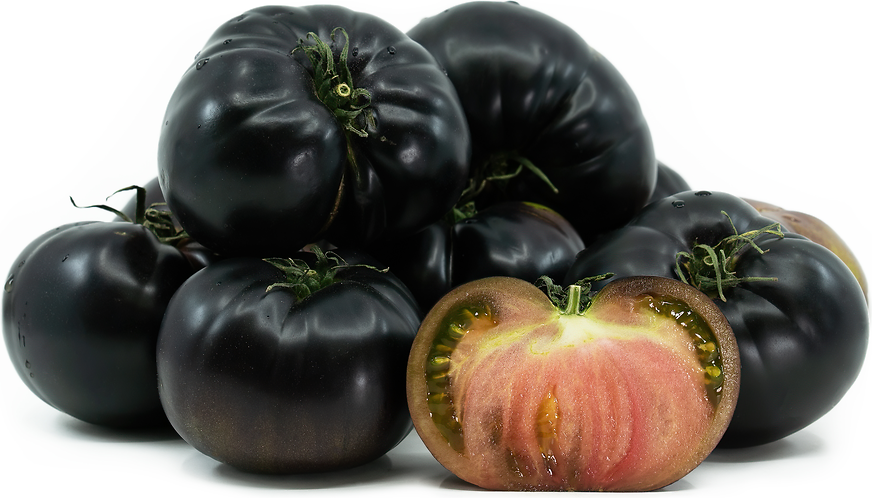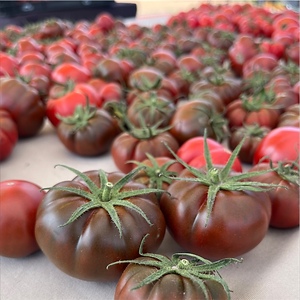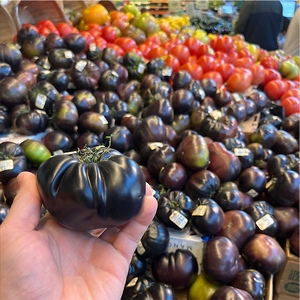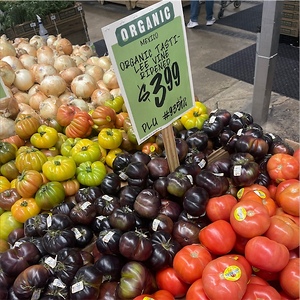


Darkloom Heirloom Tomatoes
Estimated Inventory, Case : 0
Description/Taste
Darkloom tomatoes widely range in appearance and size, depending on cultivation methods and climate, but generally have a round to oblate shape with a flattened base. The tomato’s shoulders are mostly flat, but some may showcase curved pronounced shoulders. Darkloom tomatoes have smooth, taut, and glossy skin with several ridges and creases extending from the stem to the base. The tomatoes are found in saturated hues, spanning from dark red, purple, maroon, brown, red, bronze, to mahogany. It is important to note that the coloring will vary depending on the climate and region the variety is grown in. Typically, the warmer the environment, the darker the coloring will be. Underneath the skin, the flesh is dense, aqueous, and tender with a crisp, succulent consistency. The flesh also displays variegated hues of red, green, yellow, salmon, and orange and encases small pockets of seeds suspended in a gelatinous liquid. Darkloom tomatoes are low in acidity, creating a rich, sweet, and earthy flavor with subtle smokey undertones.
Seasons/Availability
Darkloom tomatoes are available in the late winter through spring.
Current Facts
Darkloom tomatoes, botanically classified as Solanum lycopersicum, are an heirloom variety belonging to the Solanaceae or nightshade family. The pigmented cultivar is a part of a larger grouping of tomato varieties labeled as black or brown tomatoes. These cultivars are categorized under this grouping by the unique characteristic of having an excess amount of chlorophyll or green pigment. Chlorophyll gives the tomato a “brown” or “black” hue when mixed with the dark red tones of the flesh and skin. Black tomatoes are native to Eastern Europe, where pigmented varieties are widely cultivated for their appearance, flavor, and dense nature. Experts estimate there are at least 50 varieties of black tomatoes, including well-known cultivars such as Black Krim, Chocolate Stripes, Black Beauty, Black Prince, or Cherokee Purple. Darkloom tomatoes are a recent variety introduced into the United States through growers in Mexico. The cultivar is still considered rare in American markets and is promoted as a specialty tomato with a complex, balanced flavoring. Darkloom tomatoes can be utilized in fresh and cooked preparations and are favored as slicing tomatoes.
Nutritional Value
Darkloom tomatoes are a source of vitamin C to strengthen the immune system while reducing inflammation and vitamin A to maintain healthy organ functioning. The tomatoes also provide potassium to balance fluid levels within the body, fiber to regulate the digestive tract, iron to develop the protein hemoglobin for oxygen transport through the bloodstream, and calcium to build strong bones and teeth. In addition to vitamins and minerals, Darkloom tomatoes contain lycopene, a natural compound that gives the tomatoes their red coloring. Lycopene has antioxidant properties to protect the cells against free radical damage. Darkloom tomatoes also contain higher amounts of chlorophyll than other varieties, giving the tomatoes their signature dark red and purple hue.
Applications
Darkloom tomatoes have an earthy, sweet, and savory flavor suited for fresh and cooked preparations. The variety is known for its dense, meaty flesh that does not fall apart, making them a popular choice for sandwiches, caprese, and avocado toast. Darkloom tomatoes are also sprinkled with salt, fresh herbs, and balsamic to create a simple appetizer, tossed into salads, chopped as a colorful bruschetta, or diced into salsa and dips. In addition to raw preparations, Darkloom tomatoes retain their flavor when heated and are used in sauces, soups, and curries. The coloring will dimmish slightly with heat, but the tomatoes can be roasted as a savory side, mixed into pasta, or baked as a topping on pizza. The tomatoes can also be incorporated into any recipe calling for heirloom tomatoes. Darkloom tomatoes pair well with herbs such as basil, oregano, parsley, and thyme, aromatics including garlic, shallots, onions, and ginger, mushrooms, root vegetables, broccoli, legumes, and dark leafy greens. Whole, unwashed Darkloom tomatoes are more delicate than other varieties and will only keep 5 to 7 days when stored in a cool, dry, and dark place.
Ethnic/Cultural Info
Darkloom tomatoes were recognized at the 2020 GS1 Cuisine Fest in Mexico. The annual event is centered around promoting small and medium-sized enterprises working in the food and beverage industry. Participants in the event present their brand or product innovation to a panel of experts and share why their vision is unique to the industry while highlighting their fair trade practices. Ten finalists were selected in 2020, including Darkloom tomatoes from Covilli Brand Organics, a grower of heirloom tomatoes in Mexico. Covilli Brand Organics grows Darkloom tomatoes in the Valle de Guadalupe and Valle de Empalme Sonora. The Valle de Guadalupe is quickly becoming known as an international wine destination, and the region is filled with cutting-edge farm-to-table restaurants, wineries, boutique hotels, and farms. Darkloom tomatoes thrive in the valley’s warm climate year-round, and the dark purple tomatoes are exported to retailers throughout the United States.
Geography/History
Darkloom tomatoes are descendants of black tomato varieties native to Eastern Europe. Tomatoes, in general, were discovered in South America, but over time, explorers introduced tomato seeds to Europe around the 17th century. Tomatoes spread throughout the continent, eventually becoming established as a favored home garden plant. Experts believe black tomatoes arose from tomato cultivation in the Crimean Peninsula, a land bordered by the Black Sea and the Sea of Azov. The Peninsula is known for its hot, dry climate, which favors the growth of black tomatoes and helps to develop their saturated coloring. The variety was only known in the Crimea region until Russian soldiers carried seeds returning home from the Crimean War in the early 1800s, spreading black tomato varieties across Eastern Europe and Central Asia. Black tomatoes have been extensively bred over time to create new varieties in sizes from cherry to large, fleshy cultivars, and the pigmented varieties quickly became the tomato of choice in Eastern Europe. Black tomatoes were later introduced to the United States and Mexico, where specialty breeders have been naturally improving the pigmented tomatoes and are slowly introducing these varieties into consumer markets. Darkloom tomatoes are primarily grown in Mexico and are imported into the United States. The variety thrives in Mexico’s warm and sunny climate, and the tomatoes are cultivated naturally in fields or grown in greenhouses. Darkloom tomatoes are more challenging to produce than other tomato varieties and are difficult to store, leading them to be sold at premium prices. When in season, Darkloom tomatoes are offered through select retailers, distributors, and health food stores.
Recipe Ideas
Recipes that include Darkloom Heirloom Tomatoes. One
| BB Online |
|
Black Krim Tomato Marmalade |
| Food dot com |
|
Black Cherry Tomato Pasta Sauce |
| Delish |
|
Caprese Tomatoes |
| The Kitchn |
|
Fresh Tomato Bruschetta |










